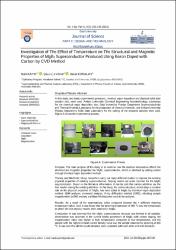| dc.contributor.author | Kaya, Naki | en_US |
| dc.contributor.author | Çavdar, Şükrü | en_US |
| dc.contributor.author | Koralay, Haluk | en_US |
| dc.date.accessioned | 2022-01-04T12:37:33Z | |
| dc.date.available | 2022-01-04T12:37:33Z | |
| dc.date.issued | 2021 | en_US |
| dc.identifier.citation | KAYA N,ÇAVDAR Ş,KORALAY H (2021). CVD Yöntemi ile Karbon Katkılanmış Bor Kullanılarak Üretilen MgB2 Süperiletkeninin Yapısal ve Manyetiksel Özelliklerine Sıcaklık Etkisinin İncelenmesi. Gazi Üniversitesi Fen Bilimleri Dergisi Part C: Tasarım ve Teknoloji, 9(2), 235 - 245. | en_US |
| dc.identifier.issn | 2147-9526 | |
| dc.identifier.uri | https://doi.org/10.29109/gujsc.887430 | |
| dc.identifier.uri | https://hdl.handle.net/20.500.12294/2920 | |
| dc.description.abstract | Carbon, which is known to play a improvement role on the superconductivity properties of MgB2, was doped into MgB2 by CVD (chemical vapor deposition) method, and the change of structural and magnetic properties observed in MgB2 in relation to the change of reaction temperature was investigated. In this context, in the sample preparation step, amorphous nano boron powders with carbon added by chemical vapor deposition method were mixed with magnesium powders at certain mass ratios and sintered at four different temperatures (700-800- 900-1000 0C) with the classical solid state reaction method and converted into carbon-added MgB2 samples. SEM photographs of amorphous nano-boron powders with carbon added were taken and subjected to elemental analysis. The structural and magnetic properties of the samples obtained were examined. X-ray diffraction graph, magnetization values and Magnetic Field-Magnetic Moment (M-H) graphs of the samples obtained by XRD method and the critical current density values with Bean Method were found and Magnetic Field-Critical Current Density (Jc-H) graph was created. It was determined that, in all the samples obtained, the MgB2 superconductor structure was formed and the carbon structures included in the structure caused changes in the lattice parameters due to the ion radius difference, that fracture occurred in the magnetization curve of the sample prepared by sintered at 1000 0C due to the intense impurities caused by the phase transitions due to the high temperature, in samples prepared at low temperatures, and that magnetization curves that could not expand sufficiently were observed, flux jumping occurs in the magnetization curve and this also affected the critical current density. In addition, the change in the critical current density value from 7.0x103 A/cm2 to 2.8x104 A/cm2 showed that the reaction temperature was an effective parameter on the experimental results. As a result of the examinations, when compared between the 4 different sintering temperature values used, it was found that the sintering temperature of 900 0C was the temperature at which the best physical results were obtained in MgB2. | en_US |
| dc.language.iso | eng | en_US |
| dc.publisher | Gazi Üniversitesi | en_US |
| dc.relation.ispartof | Gazi Üniversitesi Fen Bilimleri Dergisi Part C : Tasarım ve Teknoloji | en_US |
| dc.identifier.doi | 10.29109/gujsc.887430 | en_US |
| dc.identifier.doi | 10.29109/gujsc.887430 | |
| dc.rights | info:eu-repo/semantics/openAccess | en_US |
| dc.subject | Chemical Vapor | en_US |
| dc.subject | Deposition | en_US |
| dc.subject | MgB2 | en_US |
| dc.subject | Magnetization | en_US |
| dc.title | Investigation of The Effect of Temperature on The Structural and Magnetic Properties of MgB2 Superconductor Produced Using Boron Doped with Carbon by CVD Method | en_US |
| dc.title.alternative | CVD Yöntemi ile Karbon Katkılanmış Bor Kullanılarak Üretilen MgB2 Süperiletkeninin Yapısal ve Manyetiksel Özelliklerine Sıcaklık Etkisinin İncelenmesi | en_US |
| dc.type | article | en_US |
| dc.department | Meslek Yüksekokulu, Optisyenlik Programı | en_US |
| dc.identifier.volume | 9 | en_US |
| dc.identifier.issue | 2 | en_US |
| dc.identifier.startpage | 235 | en_US |
| dc.identifier.endpage | 245 | en_US |
| dc.relation.publicationcategory | Makale - Uluslararası Hakemli Dergi - Kurum Öğretim Elemanı | en_US |


















